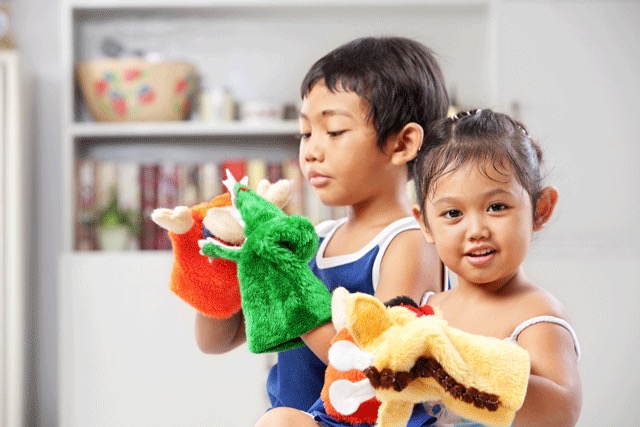Hand puppets were a big part of the children’s TV experience when I was growing up—Mr. Moose and Bunny Rabbit on Captain Kangaroo, Shari Lewis’ Charley Horse, and Lambchop, to name only a few. They had a very high entertainment factor; kids could count on something unpredictable and funny happening when one of those puppets appeared.
For several decades, I’ve had custody of a hand puppet called Wiggin, a rabbit made from an extra-large white cotton sock, with a whiffle ball head and pink polka-dot ears and arms. Wiggin wasn’t a TV star, but he did have some fans at one time. He was one of the first puppets my aunt Janet Kinder used in her work as a storyteller in the children’s program at her small-town church. The stories, which she has now shared with several generations of children, subtly address moral and ethical concerns ranging from gossip and bullying to war and civil rights.
Over the years she has designed and constructed a veritable regiment of figures to go with the storytelling. She decides on a personality for each puppet, and it appears in stories that fit its particular traits. Wiggin, for example, didn’t speak aloud. He would whisper to Jan, and she would tell her listeners what he had said. The children became very fond of Wiggin. When she retired him and turned him over to me, she explained that the puppet’s “shyness” mirrored what many children feel in large social situations, so they watched closely as she told stories to see how he would respond. So Wiggin was more than just an entertaining prop.
Part of the appeal of puppets like Wiggin is that they can “behave” like people while not exactly being people. The user can make the puppet move, talk, gesture, and react to its surroundings. A puppet operated by another person can help a child understand perspectives other than her own or see a new way she might respond to a difficult situation.
When a child is the one animating a puppet, he has control over whatever it says and does. Through the puppet, he can tell stories or interact with other people. The puppet permits “psychological distance” from aspects of those stories and interactions that might cause him discomfort. Pretending with puppets can help children express feelings about their lives, practice ways to communicate with peers, or gain mastery over fears. This can be especially important for grieving or traumatized children or those who have certain mental health disorders. But typically developing children who haven’t experienced trauma also find puppets psychologically and socially useful.
Early childhood educators generally recognize that children can benefit from having access to puppets, even when therapy isn’t the goal. One of the most thorough accounts available of what can happen when teachers make puppets a key part of classroom life can be found in a 2008 Early Childhood Research & Practice article, “ ‘Fixing Puppets So They Can Talk’: Puppets and Puppet Making in a Classroom of Preschoolers with Special Needs.” The author, Kelli Servizzi, became interested in finding out what her two preschool classes might do with puppets, so she brought in a basket of inexpensive hand puppets and left it out for them to find.
A small group of boys discovered it and began to make the puppets fight. When this kind of play continued for several days, Kelli modeled some friendlier interactions, and children began to follow suit, arranging more sociable times for their favorite puppets. They also worked through problems involved in performing puppet shows together. The teachers incorporated puppets into book-sharing time and noted positive changes in children’s attention to the stories (much as my aunt did with Wiggin and her other creations). Puppet experts were invited to speak to the classes, and the children learned how to “work” a variety of puppets. The teachers encouraged them to make their own finger puppets, paper bag puppets, and stick puppets. The puppet activities culminated in a two-hour workshop led by professional puppeteers, during which the children constructed puppets from spoons, spatulas, toy garden tools, and an array of scraps and found objects.
If you’re considering giving puppets a role in your teaching, the article is full of food for thought.
Incidentally, some researchers have tried to find out whether young children think a puppet is alive when animated by someone’s hand and voice. The findings (and practical experience) suggest that many children are uncertain about that. In fact, the title of Kelli’s article was inspired by a moment when she discovered 3-year-old Nate on the floor behind the classroom puppet stage with tools and some hand puppets. He explained that he was “fixing puppets so they can talk. Then they will be real.”

Jean Mendoza
Jean Mendoza holds a Ph.D. in curriculum and instruction from University of Illinois, a master’s degree in early childhood education from the University of Illinois, and a master’s in counseling psychology from Adler University of Chicago. She served on the faculty of the early childhood teacher education program at Millikin University and worked with children and families for more than 25 years as a teacher, social worker, and counselor. She recently collaborated with Dr. Debbie Reese on a young people’s adaptation of An Indigenous Peoples’ History of the United States (by Roxanne Dunbar-Ortiz). Her long-standing interest in children’s literature is reflected in her reviews of children’s books with Native content, which have appeared in A Broken Flute and on the blog American Indians in Children’s Literature. Jean and her late husband, Durango, have four grown children and six grandchildren. She lives in Urbana, Illinois.
Biography current as of 2021
Web Resources
-
“ Fixing Puppets So They Can Talk”: Puppets and Puppet Making in a Classroom of Preschoolers with Special Needs
(also in Spanish)Source: Early Childhood Research and Practice
This article describes how a classroom of young children with special needs engaged with puppets and puppet-making.


